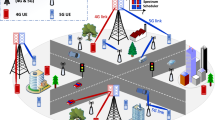Abstract
For IEEE 802.11 DCF networks in ad-hoc mode, how to achieve the maximum throughput in a distributed manner draws much attention in previous studies. The problem becomes challenging for partially-saturated heterogeneous networks with multiple groups, as the optimal access parameters not only depend on the group size of saturated groups but also the aggregate input rate of all the unsaturated groups, both of which are hard to obtain without a central controller. In this paper, a novel distributive scheme is proposed for partially-saturated heterogeneous IEEE 802.11 DCF networks to achieve the maximum network throughput. With the proposed scheme, each saturated transmitter can obtain the optimal initial backoff window size distributively by two estimation rounds. In each estimation round, each saturated transmitter only needs to count the number of busy intervals and ACK frames on the channel. For fully-saturated networks, only one estimation round is needed. It is shown by extensive simulations that the proposed scheme can achieve the maximum network throughput in a distributive manner.









Similar content being viewed by others
Notes
Furthermore, it was shown in [16] that the node-throughput ratio is also determined by the initial backoff window size. Therefore, the ratio of the initial backoff window sizes remains unchanged so as to meet certain throughput differentiation requirement.
With carrier sensing, each transmitter can determine whether one transmission on the channel is successful or not by detecting the ACK frame, as shown in Fig. 1.
Note that if the scale factor \(C<1\), each saturated transmitter would have a smaller initial backoff window size, and access the channel more frequently. In this case, the channel contention becomes more fierce. Consequently, the unsaturated transmitter may become saturated. To prevent this from happening, the scaling factor is set to be larger than 1.
References
Gupta, A., Min, J., & Rhee, I. (2012). WiFox: Scaling WiFi Performance for Large Audience Environments. Proceedings of CoNEXT (pp. 217–228)
Bianchi, G. (2000). Performance analysis of the IEEE 802.11 distributed coordination function. IEEE J Sel Areas Commun, 18(3), 535–547.
Bianchi, G., & Tinnirello, I. (2003). Kalman filter estimation of the number of competing terminals in an IEEE 802.11 network. Proceedings of IEEE INFOCOM (vol. 2, pp. 844–852), doi:10.1109/INFCOM.2003.1208922
Toledo, A., Vercauteren, T., & Wang, X. (2006). Adaptive optimization of IEEE 802.11 DCF based on Bayesian estimation of the number of competing terminals. IEEE Trans Mob Comput, 5(9), 1283–1296. doi:10.1109/TMC.2006.124.
Cali, F., Conti, M., & Gregori, E. (2000). Dynamic tuning of the IEEE 802.11 protocol to achieve a theoretical throughput limit. IEEE/ACM Trans Netw, 8(6), 785–799.
Dai, L., & Sun, X. (2013). A unified analysis of IEEE 802.11 DCF networks: Stability, throughput, and delay. IEEE Trans Mob Comput, 12(8), 1558–1572.
Li, B., Battiti, R., & Fang, Y. (2007). Achieving optimal performance by using the IEEE 802.11 MAC protocol with service differentiation enhancements. IEEE Trans Veh Technol, 56(3), 1374–1387. doi:10.1109/TVT.2007.895565.
Freitag, J., & da Fonseca, N. L. S. (2006). Tuning of 802.11e network parameters. IEEE Commun Lett, 10(8), 611–613. doi:10.1109/LCOMM.2006.1665127.
Gao, Y., Sun, X., & Dai, L. (2014). IEEE 802.11e EDCA networks: Modeling, differentiation and optimization. IEEE Trans Wirel Commun, 13(7), 3863–3879.
Heusse, M., Rousseau, F., Guillier, R., & Duda, A. (2005). Idle sense: An optimal access method for high throughput and fairness in rate diverse wireless LANs. SIGCOMM Comput Commun Rev, 35(4), 121–132.
Cali, F., Conti, M., & Gregori, E. (2000b). IEEE 802.11 protocol: Design and performance evaluation of an adaptive backoff mechanism. IEEE J Sel Areas Commun, 18(9), 1774–1786. doi:10.1109/49.872963.
Ge, Y., Hou, J. C., & Choi, S. (2007). An analytic study of tuning systems parameters in IEEE 802.11e enhanced distributed channel access. Comput Netw, 51(8), 1955–1980.
Le, Y., Ma, L., Cheng, W., Cheng, X., & Chen, B. (2015). A time fairness-based MAC algorithm for throughput maximization in 802.11 networks. IEEE Trans Comput, 64(1), 19–31. doi:10.1109/TC.2013.186.
Mao, J., Mao, Y., Leng, S., & Bai, X. (2009). A simple adaptive optimization scheme for IEEE 802.11 with differentiated channel access. IEEE Commun Lett, 13(5), 297–299.
Hu, C., & Hou, J.C. (2007). A Novel Approach to Contention Control in IEEE 802.11e-Operated WLANs. Proceedings of IEEE INFOCOM (pp. 1190–1198)
Gao, Y., Sun, X., & Dai, L. (2013). Throughput optimization of heterogeneous IEEE 802.11 DCF networks. IEEE Trans Wirel Commun, 12(1), 398–411. doi:10.1109/TWC.2012.120312.120827.
Ni, J., Tan, B., & Srikant, R. (2010). Q-CSMA: Queue-Length Based CSMA/CA Algorithms for Achieving Maximum Throughput and Low Delay in Wireless Networks. Proceedings of INFOCOM (pp. 1–5)
Jiang, L., & Walrand, J. (2011). Approaching throughput-optimality in distributed CSMA scheduling algorithms with collisions. IEEE/ACM Trans Netw, 19(3), 816–829.
Wu, D., Bao, L., Regan, A. C., & Talcott, C. L. (2013). Large-scale access scheduling in wireless mesh networks using social centrality. J Parallel Distrib Comput, 73(8), 1049–1065.
Wu, D., Bao, L., & Liu, C. H. (2013). Scalable channel allocation and access scheduling for wireless internet-of-things. IEEE Sens J, 13(10), 3596–3604.
Corless, R., Gonnet, G., Hare, D., Jeffrey, D., & Knuth, D. (1996). On the LambertW function. Adv Comput Math, 5(1), 329–359.
IEEE 802.11n-2009. (2009). Wireless LAN Medium Access Control (MAC) and Physical Layer (PHY) Specifications Amendment 5: Enhancements for Higher Throughput.
Acknowledgements
This work is supported in part by the National Natural Science Foundation of China (Grant Nos. 61401224 and 61402186), in part by the Natural Science Foundation of Jiangsu Province of China (Grant No. BK20140882), in part by NUPTSF (Grant No. NY213061) and in part by China Scholarship Council.
Author information
Authors and Affiliations
Corresponding author
Rights and permissions
About this article
Cite this article
Sun, X., Gao, Y. Distributed throughput optimization for heterogeneous IEEE 802.11 DCF networks. Wireless Netw 24, 1205–1215 (2018). https://doi.org/10.1007/s11276-016-1392-y
Published:
Issue Date:
DOI: https://doi.org/10.1007/s11276-016-1392-y




